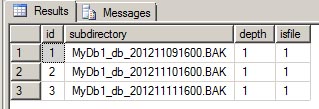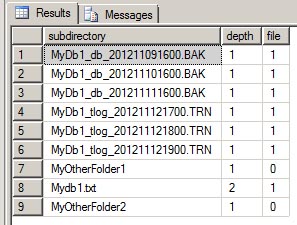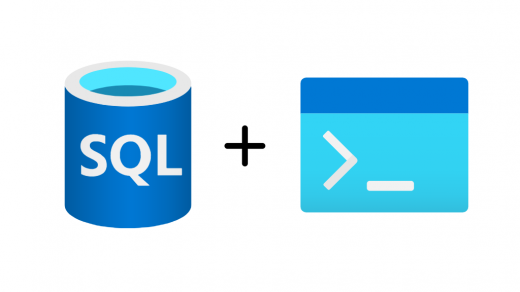UPDATED — Dec 31, 2012 — Be sure to read Part 2 of this post discussing xp_dirtree.
Last week I blogged about how to use an undocumented stored procedures to create folders. This week we need to do the opposite. We need to get a list of all files from a subfolder in order to process them. In order to do that, we’ll use another undocumented extended stored procedure; master.sys.xp_dirtree. This stored procedure will display a list of every folder, every subfolder, and every file for path you give it.
Xp_dirtree has three parameters:
- directory – This is the directory you pass when you call the stored procedure; for example ‘D:\Backup’.
- depth – This tells the stored procedure how many subfolder levels to display. The default of 0 will display all subfolders.
- file – This will either display files as well as each folder. The default of 0 will not display any files.
For today’s example, we just want to display all of our backup files (*.BAK) in a particular folder. We need to all of the other parameters in order to show the files as well as any subfolders.
EXEC master.sys.xp_dirtree 'D:\Backup\TRON4\TEST2\MyDb1',0,1;
The output below will show us each subfolder and every file for the given directory.
We’re only concerned about the BAK files. So we’ll need to create a temp table to hold the output of xp_dirtree. Then we can select only the rows that are an actual file (isfile = 1) and that have a file extension of BAK.
IF OBJECT_ID('tempdb..#DirectoryTree') IS NOT NULL
DROP TABLE #DirectoryTree;
CREATE TABLE #DirectoryTree (
id int IDENTITY(1,1)
,subdirectory nvarchar(512)
,depth int
,isfile bit);
INSERT #DirectoryTree (subdirectory,depth,isfile)
EXEC master.sys.xp_dirtree 'D:\Backup\TRON4\TEST2\MyDb1',1,1;
SELECT * FROM #DirectoryTree
WHERE isfile = 1 AND RIGHT(subdirectory,4) = '.BAK'
ORDER BY id;
GO
Below is the output.

This example only shows the files for a specific subfolder, which is used to get a list of files that are needed for purging before another database backup runs. This stored procedure also can accept UNC paths (\\ServerFolder) to get a list of files and subfolders from a network drive. In a future post, I will add on to this script to show all files in all subfolders for a given directory. Until then, play around with xp_dirtree and its parameters to see the different outputs. You may be able to incorporate this into your own code.






Very helpful, thanks. You can also use ip address to access files on another machine:
EXEC master.sys.xp_dirtree ‘\\9.9.9\C$\\users\Bullwinkle\’,1,1;
Thanks Patrick.
Is there any way to COUNT the number of files in a directory without listing them all first with ‘xp_dirtree’?
I appreciate your help.
I am not aware of any way to access the file system through SQL server other than xp_dirtree. The example in this article loads the files into a temp table where you could perform a count against that table.
Hi my EXEC master.sys.xp_DirTree ‘C:\ KWS’,0,1 returns no results. but the directory has files. Is there something i might be missing?
DECLARE @Path nvarchar(500)
SET @Path = ‘C:\ KWS’ –Change the path’
DECLARE @FindFile TABLE
(FileNames nvarchar(500)
,depth int ,isFile int)
INSERT INTO @FindFile
EXEC master.sys.xp_DirTree @Path,0,1
SELECT FileNames
FROM @FindFile WHERE isFile=1
My guess is the SQL Server service account does not have permission to that folder.
I was getting similar results, then found out I needed to select User with code below before anything else.
EXECUTE AS USER = ‘Username’
Perfect we are getting incremental files from our source erp system (ERP LN) there is no option to get 1 file after a day. Even if there is a commit a file is generated.
This is causing that some tables have 50K files per day. Loading this file by file sequential is not performing. I wasn’t expecting to get this amount of files.
But with the usp above i can query the folder and start multiple parallel loads instead off only 1.
Thanks